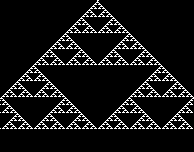Elementary Cellular Automata

An elementary cellular automata is definied by Wolfram as the simplest class of one-dimensional cellular automata. The elementary cellular automata has two possible states (labeled 0 and 1) and the rule to determine the state of a cell in the next generation depends only on the current state of the cell and its two immediate neighbors. The application below was written in Java (Processing) and the user can explore the 256 possibilities of the elementary cellular automata.
You can find more information about elementary cellular automata the following links: Wolfram Mathworld's page on Elementary Cellular Automaton; Wolfram's New kind of science online book
Cellular Automata (CA) can be used for different appllications. The SCG Group are interested in the following applications of CA: Pattern Recognition, Artificial Inteligence, Image Analysis, Cryptography, Information Theory, Complex Systems Simulations and Chaos behavior.
 This work is licensed under a Creative Commons Attribution-NonCommercial-ShareAlike 3.0 Unported License.
This work is licensed under a Creative Commons Attribution-NonCommercial-ShareAlike 3.0 Unported License.
